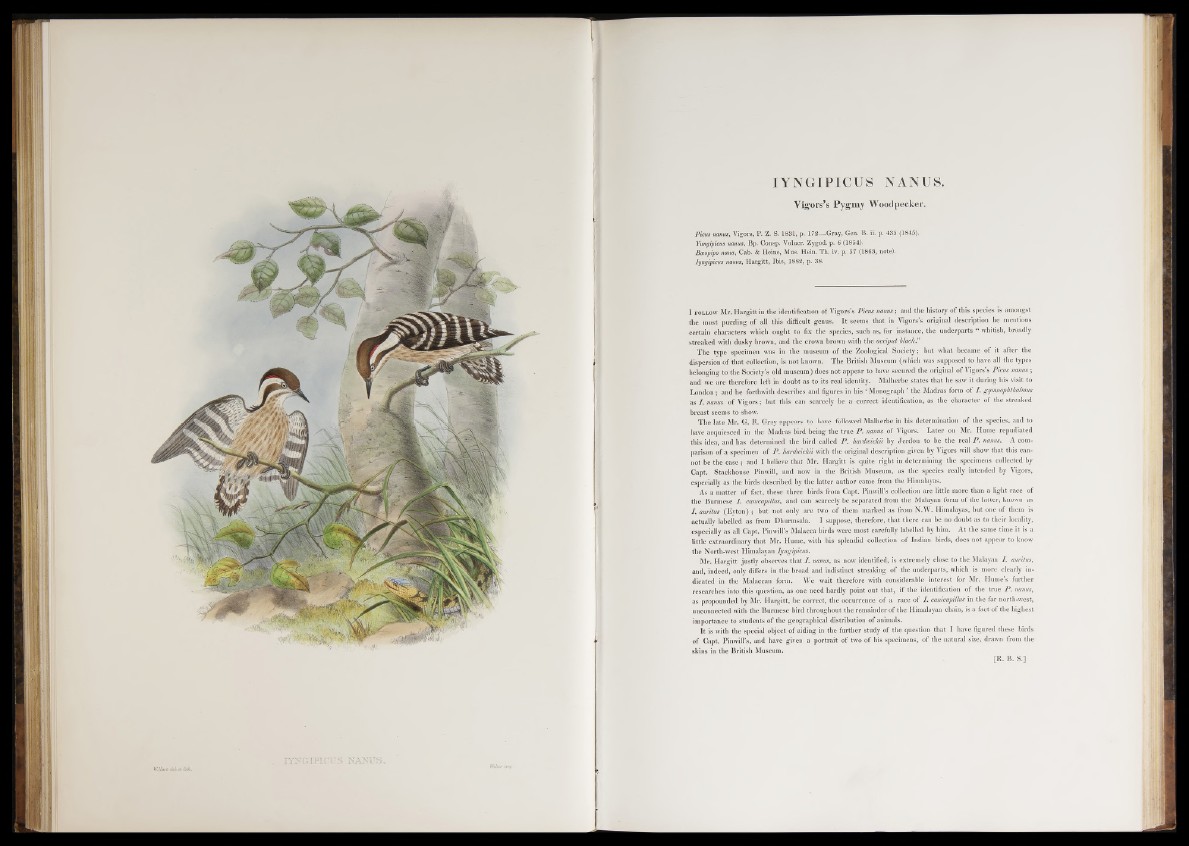
IYNGIPICUS NANUS.
Vigors’s Pygmy Woodpecker.
Picus nanus, Vigors, P. Z. S. 1831, p. 172.—Gray, Gen. B. ii. p. 435 (1845),
Yungipicus nanus, Bp. Consp. Volucr. Zygod. p. 6 (1854).
Baopipo nana, Cab. & Heine, Mus. Hein. Th. iv. p. 57 (1863, note).
Iyngipicus nanus, Hargitt, Ibis, 1882, p. 38.
I f o l l o w Mr. Hargitt in the identification of Vigors’s Picus nanus; and the history of this species is amongst
the most puzzling o f all this difficult genus. It seems that in Vigors’s original description he mentions
certain characters which ought to fix the species, such as, for instance, the underparts “ whitish, broadly
streaked with dusky brown, and the crown brown with the occiput black”
The type specimen was in the museum o f the Zoological Society; but what became of it after the
dispersion o f that collection, is not known. The British Museum (which was supposed to have all the types
belonging to the Society’s old museum) does not appear to have secured the original of Vigors’s Picus nanus ;
and we are therefore left in doubt as to its real identity. Malherbe states that he saw it during his visit to
London; and he forthwith describes and figures in his ‘ Monograph ' the Madras form o f I. gymnophthalmus
as I. nanus of Vigors; but this can scarcely be a correct identification, as the character of the streaked
breast seems to show.
The late Mr. G. R. Gray appears to have followed Malherbe in his determination o f the species, and to
have acquiesced in the Madras bird being the true P . nanus of Vigors. Later on Mr. Hume repudiated
this idea, and has determined the bird called P . hardwickii by Jerdon to be the real P . nanus. A comparison
of a specimen o f P . hardwickii with the original description given by Vigors will show that this cannot
be the ca se; and I believe that Mr. Hargitt is quite right in determining the specimens collected by
Capt. Stackhouse Pinwill, and now in the British Museum, as the species really intended by Vigors,
especially as the birds described by the latter author came from the Himalayas.
As a matter of fact, these three birds from Capt. Pinwill’s collection are little more than a light race of
the Burmese I. canicapillus, and can scarcely be separated from the Malayan form of the latter, known as
/ . auritus (Eyton) ; but not only are two of them marked as from N.W. Himalayas, but one of them is
actually labelled as from Dluirmsala. I suppose, therefore, that there can be no doubt as to their locality,
especially as all Capt. Pinwill’s Malacca birds were most carefully labelled by him. At the same time it is a
little extraordinary that Mr. Hume, with his splendid collection o f Indian birds, does not appear to know
the North-west Himalayan Iyngipicus.
Mr. Hargitt justly observes that I . nanus, as now identified, is extremely close to the Malayan I. auritus,
and, indeed, only differs in the broad and indistinct streaking of the underparts, which is more clearly indicated
in the Malaccan form. We wait therefore with considerable interest for Mr. Hume’s further
researches into this question, as one need hardly point out that, if the identification of the true P . nanus,
as propounded by Mr. Hargitt, be correct, the occurrence o f a race of I . canicapillus in the far north-west,
unconnected with the Burmese bird throughout the remainder of the Himalayan chain, is a fact o f the highest
importance to students o f the geographical distribution of animals.
It is with the special object o f aiding in the further study of the question that I have figured these birds
of Capt. Pinwill’s, and have given a portrait o f two of his specimens, o f the natural size, drawn from the
skins in the British Museum.
[R. B. S.]